Introduction
Mythgard is a new CCG from Rhino Games that is freshly in Open Beta! It is an original property from a dedicated team of industry veterans passionate about making the CCG they always wanted to play themselves! Players will be able to immerse themselves in the lush artwork and story, following motorcycle riding Valkyries of Norden and Ved’ma witches of Dreni!
Where To Play
Mythgard is currently available on Steam, iOS, Android, and can be played in your browser. Rhino Games is currently focusing all efforts on rolling out Open Beta, but localization is on the roadmap for some point in the future and as the game grows, it may also expand to consoles!
Game Overview
While many parts of Mythgard will feel familiar to experienced card game players, two features in particular deserve attention in getting started with the game: The resource system and the Game Board itself. Cards are sorted into one of six colors—Blue, Yellow, Red, Green, Orange, and Purple—and will have a cost represented with both Gems and Mana. Cards in hand can also be “cycled” giving you one additional Mana and one additional Gem to spend each turn. Because of this flexible resource system, there are no dedicated resource cards and gameplay and deck design can more fluidly and smoothly evolve without having to worry about balancing resource cards. Cards can only be cycled once and a cycled card can be identified by the cycle ring being broken. Upon being cycled, a card is reinserted into the deck. Mana can also be used to activate player Powers. Some Minions and Artifacts also have abilities that can be activated by paying a cost of Gems, Mana, or both.

The Game Board itself functions like the Battlefield in Magic, a place where Minions are summoned and combat takes place. What is specific to this zone in Mythgard blocking is determined by position rather than keywords or phases of combat. The board itself is divided into 7 Lanes for each player, and minions must be played into one of these Lanes. Minions may attack into any of the three opposing lanes but may be required to first dispatch opposing minions before directly attacking the opponent. These Lanes can also host Enchantments, providing a variety of useful effects to minions which occupy the lane or the board itself. Effect on Minions range from simple bonuses to health or attack to granting special abilities to minions, and the Enchantments can nullify abilities on opposing minions or return Minions to play after being destroyed! The destruction of an occupying Minion does not remove Enchantments, so they can be used again by future Minions, though there are spells and effects which can destroy Enchantments.
How To Play
This section will go over the basics of gameplay.
Card Types
The cards in your collection fit into four categories:
Minions: Summons a Minion into one of your unoccupied lanes. Minions have a value for Strength and Health, and some have Awaken effects which trigger when they enter play or Demise effects which trigger when they enter the Boneyard. Strength value determines damage dealt in combat with other minions and the opponent. When a Minion’s Health is reduced to zero, it is sent to the Boneyard.
Spells: A one-time effect which may generate a variety of effects, possibly targeting Cards, Players, or Lanes.
Enchantments: A permanent effect which targets one of your seven lanes, providing bonuses to the occupying minion or imposing penalties on opposing minions.
Artifacts: Cards which can provide both continuous and activated bonuses and effects for a Player while they are in play. A player may only have five Artifacts in play at one time. Many artifacts also have Durability, similar to a Minion’s Health. For each point of damage dealt directly to a player, the most recently played Artifact’s Durability is decreased by one. Artifacts with Durability reduced to zero are placed in the Boneyard.
Cards are divided into six colors, each corresponding with a Faction within the Mythgard universe:
Blue – Norden
Yellow – Aztlan
Red – Oberos
Green – Dreni
Orange – Parsa
Purple – Harmony
A card’s color determines which color gem it produces when cycled. There are no restrictions on colors in deck construction, but because cards can only be cycled once per game, decks frequently maintain concentrated color identities.
Card Anatomy

Some card types, Artifacts for example, will also have additional properties such as Durability. Check the in-game guide for more info on these additional properties.
Resource System
In Mythgard you play with two different resources: Gems and Mana. Cards will have both a Mana and a Gem cost and some special abilities of cards will also cost Mana and Gems or sometimes both. At the bottom of your screen during a match you will find your resource bar. Resources are spent automatically as you choose to play cards and abilities, and any used resources will be restored at the start of your turn. You gain both Gems and Mana by cycling cards in your hand.
Card Cycling
You can Cycle a card once per turn by dragging it from your hand to your deck during your turn. Cycled cards are reinserted randomly into your deck, but are never placed directly on top. Cycling a card will grant you 1 maximum Mana and 1 Gem of the card’s Faction. Faction is displayed on the colored strip which run through the middle of the card and Gem on the card’s right side. The ring around the mana cost in the upper-left corner also indicates a card’s Faction. Each card can only be cycled once. When a card has been cycled, it will show the ring in the top left being broken and the card face will have minor visual changes.
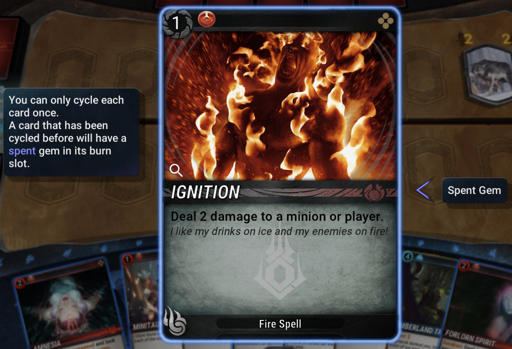
Playable Cards
During your turn, any card you are currently able to play will appear in your hand with a blue border around it. This indicates that you have enough Mana and/or Gems to play that card.

Playing Cards
To play a card, simply drag it onto the Game Board. If the card you’re playing, such as a Minion or Enchantment, goes into a Lane, you can drag it into the desired Lane. Alternatively, you can drag it to the center of the Game Board and target a Lane. Some cards such as Artifacts and untargeted Spells can simply be dragged onto the center of the Game Board. Any cards dragged to the center of the Game Board will highlight potential Lanes, Minions, Artifacts, or Players which can be targeted.
Area of Influence
Minions have an area of influence on the Game Board. A minion threatens 3 Lanes at a time, the Lane directly opposite it and the 2 adjacent lanes.

Attacking
To attack with a Minion, simply click and drag from the Minion you want to attack with and available Lanes will be highlighted in red. Minions can only attack Lanes within their area of influence and normally must attack Minions before being able to attack an empty Lane. Several keywords can alter the way this area of influence works.
Agile: “Can attack any of the three opposing lanes, ignoring attacking and blocking restrictions.”
Agile can allow you to circumvent normal attacking rules to attack your opponent directly, even while blocked by another minion. Agile also ignores blocking restrictions such as Defender and Lurker.
Defender: “Cannot attack. Enemies must attack a Defender before other blocking minions.”
Lurker: “Enemies must attack other blocking minions before a Lurker.”
Moving
Not only can your Minions attack, but they can also move around the Game Board once played. To move a Minion, click and drag from the Minion the same way you would attack with it. Lanes the Minion can move to will be highlighted in green. Minions cannot normally attack and move in the same turn and are normally bound to moving 1 Lane to either side. Several keywords can alter how movement works.
Immobile: “Cannot move voluntarily.”
Swift: “Gets an additional move action each turn. Each Minion can use only one swift move per turn. Swift moves are used before other move actions.”
Teleport: “Can move to any lane.”
Combat
Minions deal their Strength value to an opposing minion’s health. When a minion’s health is 0, it is placed in the Boneyard. If you’re unsure of the result of an attack, simply hover the attack without letting go of the attacker to be given a damage resolution preview. There are several keywords with can alter damage calculation in combat.
Slayer X: “Deals X extra damage in combat with minions.”
Fragile X: “Increases damage taken by X.”
Focused X: “Deals X extra damage in combat with the opposite lane.”
Blast X: “Deals X non-combat damage to adjacent enemy minions after striking.”
Armor X: “Reduces damage taken by X.”
Piercing: “Damage dealing cards with Piercing ignore Armor.”
Alpha Strike: “Minions with Alpha Strike deal combat damage before minions without it. If the Alpha Strike minion deals enough damage to kill a minion without Alpha Strike, the opposing minion will not get to strike in retaliation.”
Overrun: “When attacking a minion, excess damage carries over to the defending player.”
Frenzy: “Frenzy grants one Frenzy Attack after the minion uses a Standard Action or a Rush Action to attack. Only one Frenzy Attack can be used per turn.”
Deadly: “Destroys minions when dealing any amount of combat damage to them.”
Life Tap: “The controlling player gains life equal to combat damage dealt.”
Breach: “Triggers when dealing combat damage to a player.”
Abilities
Many cards have additional abilities available to them, whether through additional actions or other miscellaneous keywords.
Action Breakdown
Standard Action: “Can be used to attack, move, or activate an ability. Usually, minions don’t have one the turn they are summoned. Minions gain one standard action at the start of their turn.”
Rush Action: “Rush actions are like standard actions and are granted by Rush. Only one can be used per turn and they are used before standard actions.”
Move Action: “Can only be used to move and are used before Standard Actions.”
Swift Move: “Can only be used to move and are granted by Swift. Only one can be used per turn, and they are used before move actions.”
Frenzy Attack: “Frenzy grants one Frenzy Attack after the minion uses a Standard Action or Rush Action to attack. Only one Frenzy Attack can be used per turn.”
Utility Action: “Can be used to activate abilities requiring Utility Actions. Actions that require energy are always Utility Actions. Usually, Minions, Artifacts and Brands get one Utility Action per Turn including the turn they come under your control.”
Misc. Keywords
In addition to the above mentioned abilities there are numerous others that don’t fit into the previous categories.
Warded: “Cannot be damaged or destroyed outside of combat.”
Immortal: “Cannot be damaged and immuned to destroy effects.”
Awaken: “An ability that triggers when entering play.”
Demise: “An ability that triggers when destroyed.”
Banish: “Removed from the game without triggering Demise effects or going to the boneyard.”
Blight X: “At the start of its turn, gets -X/-X.”
Regen X: “At the end of its turn, restores X health.”
Sacrifice: “Sent to the boneyard. Demise effects are triggered. Abilities that prevent destroy effects do not prevent sacrifice effects.”
Sap: “Spend an amount of current and maximum health to activate an ability.”
Divination X: “Look at the top X cards of your deck. Pick one to put on top; shuffle the rest into your deck below it.”
Stealth: “Identity is hidden from opponents and blocks like a regular minion until it is dealt damage, is destroyed, interacts with others, uses an ability (including Awaken abilities), or takes a non-move action. Spell Previews are turned off if any minion in stealth is in play.”
Stunned: “Cannot attack, move, or activate abilities.”
Empower: “Can be activated or triggered once to improve a minion.”
Energy: “Minions, artifacts, and paths with energy have abilities that generate and consume it. Using energy with an action requires a utility action.”
Suppressed: “Nullifies all special abilities, buffs and debuffs. Abilities, buffs, and debuffs gaained while suppressed are also nullified until the suppression effect wears off.”
Unsuppressable: “Cannot be Suppressed.”
Ephemeral: “Removed from the game when leaving play, going to a boneyard, or returning to a deck.”
Pursuit: “An ability that applies when you go second in the starting turn order.”
Card Rarity
Cards come in 4 rarities. You can find the rarity of a card by looking at the medallion in the top right corner of the card. Rarity will dicated how often you find cards in packs and in Gauntlet/Arena game modes. There are deck building restrictions and crafting costs based on rarity as well, which we will cover in the Deck Building Rules section later.
Bronze: Common
Silver: Uncommon
Gold: Rare
Diamond: Mythic
Paths
When building a deck, you will choose a path to either complement your play style or even potentially build your deck around.
Disk of Circadia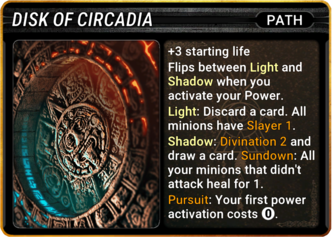 | Fires of Creation |
Journey of Souls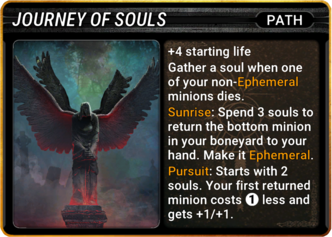 | Rainbow’s End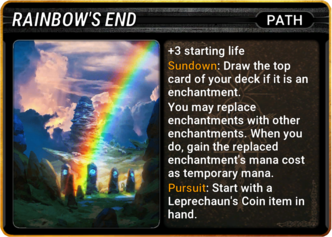 |
Turn of Seasons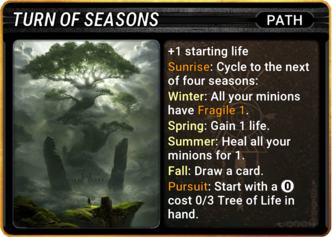 |
Powers
When building a deck, you will also choose a Power, which can be activated once per turn for a cost.
Foresight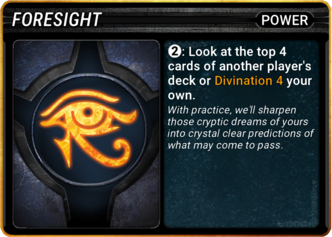 | Impel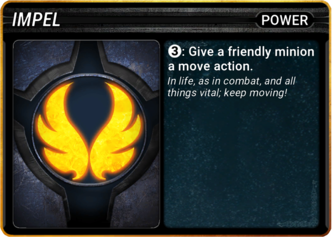 |
Infuse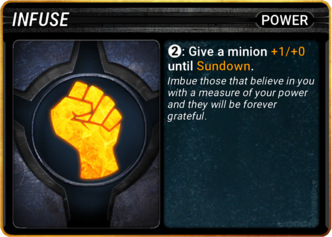 | Mend |
Reconstruct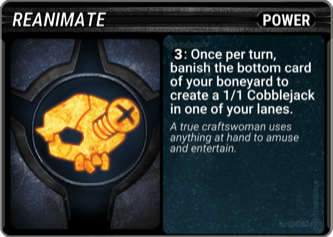 | Smite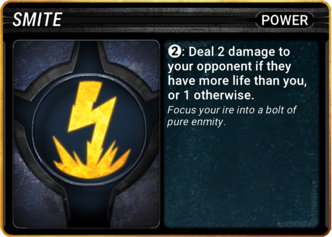 |
Deck Building
In the deck editor you can create/edit/copy/delete your decks as well as view/copy your current featured decks. A deck must contain a minimum of 40 cards and can not contain more than 200.
Number of Cards per Rarity
In Mythgard, the rarity of a card limits the number of copies of that card you may put in your deck. They are as follows:
Common: 4x
Uncommon: 3x
Rare: 2x
Mythic: 1x
Essence Values
Essence is the crafting currency of Mythgard. Essence can be gained by unmaking cards you own and can be used to make cards you do not own. Cards of different rarities have different essence values associated with them. They are as follows:
Commons: Unmake for 10 essence and cost 50 essence to make.
Uncommons: Unmake for 20 essence and cost 100 essence to make.
Rares: Unmake for 100 essence and cost 500 essence to make.
Mythics: Unmake for 600 essence and cost 2400 essence to make.
Wildcards
Wildcards are a crafting resource that can be opened in packs or earned as Maat Rewards. Wild Cards have a specific rarity, card set and Faction associated with them. A Wildcard can be used to craft a card of the corresponding rarity, Faction and set instead of its essence cost. They can also be unmade for essence at double the standard rate of their corresponding rarity.
After you have completed the start of your journey through Mythgard, you will also be given 3 special missions. These missions reward you with a total of 2 Mythic and 2 Rare wildcards that aren’t locked to any specific Faction, allowing you to create any card of those rarities you wish.
Game Economy
Coins
Coins are Mythgard’s in-game currency and can be earned in a large variety of ways simply by playing the game. The main use of Coins is buying packs of cards and entry into the Arena.
Mythril
Mythril is Mythgard’s premium currency that you can purchase with real money in the game’s store. Mythril can be spent in-game on card packs, Arena entry and for upgrading cards you own into their Prestige versions.
Maat
Maat is a special reward that you get if all players of a PvP game click the thumbs up button in the bottom right corner of the screen following the conclusion of a match. Maat rewards you with Wildcards and is a very important part of the economy. Remember to thumbs up for Maat if you had a good game against your opponent.
Coin Acquisition
Missions
You can earn coins through missions that are granted to you daily. Be sure to check the Missions tab in-game to see your current missions. Mission coin values are not static and vary from 600 to 900.
Achievements
You can earn coins for completing achievements as you advance through Mythgard. Be sure to check the Missions tab in-game to see your current achievement progress.
Game Rewards
Different game modes off differing amounts of coin as rewards. Note that winning games also gets you 1 card per win for your first 3 wins per day.
1v1 vs Players up to 120 coins
1v1 vs Ai up to 50 coins
2v2 vs Players up to 180
Weekly Chest
The Weekly Chest can be unlocked once every seven days and can be found under the Missions tab. In order to unlock the Chest, you will need 5 Seals. Seals are a rare reward for winning any match. You can also earn a guaranteed seal for a perfect Gauntlet run. The Chest contains large sums of Coins, the average amount is around 2,400 but can go as high as 12,000.
The chance to get a Seal varies for each of the different game modes:
25% chance to get a Seal for 1v1 PVP wins
38% chance to get a Seal for 2v2 PVP wins
10% chance to get a Seal for 1v1 PvE wins
100% chance to get a Seal for perfect gauntlet wins
Level Up Rewards
As you gain experience in game you will level up. Each level comes with its own rewards, ranging from essence to entire card packs. A list of all the level up rewards can be found under your profile in-game.
Coin Spending
Packs
A pack of cards costs 1200 Coins and will normally contain 3 Commons, 2 Uncommons and 1 Rare. Each rare has approximately a 10% chance to upgrade to a Mythic. The longer you go without a Mythic after 10 packs, the higher than upgrade percentage becomes.
You cannot open a copy of a Mythic you already own unless you already own all Mythics but you can open additional copies of cards of other rarities.
In addition to Mythics, you also have a small chance to replace any card in the pack with a Wildcard of the corresponding rarity or a Prestige card. Just over 14% of packs will upgrade one or more cards to Wildcards and the same is true of Prestige cards as well.
Arena
While the primary entry into Arena is free with a cooldown, more on that below, you can always skip the cooldown period by paying 1800 coins and starting a new Arena run. The coins are deposited in “escrow” which can be won by opponents or won from opponents in addition to the normal Arena rewards.
Game Modes
Story Mode
Follow the adventures of Percy, Fen, Ariel, and many more! Story mode features comic-book style artwork leading to PvE combat with themed enemies. Chapter One also contains the Tutorial which yields more coins than average and guarantees enough XP to unlock all other game modes!
Casual
Constructed play that matches you with other players outside of the Ranked ladder. Fun and weird decks are always welcome and it’s a great place to test and practice without worrying about losing any Ranked Points (RP).
Ranked
Competitive constructed ladder player in which you can climb from the very bottom of the Bronze ladder all the way up to Mythril and beyond! Wins and losses add and subtract RP. Every 100 RP within each Ladder–Bronze, Silver, Gold, and Mythril–brings you to the next division (i.e. Bronze 01 to Bronze 02). These divisions provide a soft floor within the ladder, first taking you to 0 RP in that division before moving down to the previous division. There are 10 divisions per Ladder.
Melee (2v2)
Just what it says on the tin! Two teams of two face off in a chaotic and exciting action-packed format. Players each have six Lanes of their own but share the middle Lane, allowing them to pass Minions back and forth. Players can similarly target the opponent directly opposite them or diagonal from them, or even target friendly minions on their partner’s Lanes.
Brawl (vs AI)
Casual constructed gameplay against AI opponents with no turn timer and the ability to suspend games and return to them later. Brawl games can be played while you are waiting to match with opponents in any of the other game mode’s queues, but like any matches against AI, award less XP than PvP games.
Puzzle
The first set of puzzles provides a tutorial experience, highlighting interesting mechanics of Mythgard. Later puzzles, those which award 100 coins instead of 30, feature fiendishly clever board states which have lethal solutions for the most creative and crafty players!
Gauntlet
Draft a deck from simulated packs and test your creative skills against the AI’s own drafted concoctions! The packs simulate signalling in booster drafts, and allow you determine the colors you are building around and entry is completely free. AI opponents become increasingly challenging as you work your way through gauntlets of 5, 7, and finally 9 matches, only advancing if you win. While the prizes are the same as other PvE matches, completing gauntlets guarantee seals for unlocking the weekly chest and are guaranteed to unlock a Path or Power!
Arena
Same limited format as Gauntlet, but you are competing with your fellow Mythgardians! PvP limited also comes in 9 match runs, which are free to enter with a 9 day cooldown which is reduced for each game played. If you want to end your run early, you can pay a fee in coins to re-enter, at which point winning 5 of your 9 matches will return your invested coin. Unlike Gauntlet, you will play all 9 matches every time and for every two matches you lose, you will be given a bonus draft to shore up your deck.
First Hours
Story Mode Completion
Playing through the Story, as mentioned above, no only gives you a game tutorial and a fun look at the world of Mythgard, but also guarantees certain cards will be added to your collection, including some handy rares like Misanthropia. The XP gain from the Story is exactly the amount needed to get you to level 6, at which point all game modes are unlocked, so it is a good way to invest some time early on.
Puzzle Mode Completion
After finishing Story mode, you should try your chops at the Puzzle mode as a good way to earn some extra coin.
Gauntlet Mode Leveling
As mentioned above, because each complete Gauntlet run guarantees an unlocked Path or Power, this is by FAR the fastest method for unlocking all of the various elements of deck building. The completely free format is fun, though the AI doesn’t have quite the same killer instinct as human opponents. This is also a great way to get more familiar with cards in the Core Set, as you will be able to see many of them as you go through drafts and get to test drive many different decks as you fill out your collection of Paths and Powers!
Starting Missions
When you start playing, you will notice in the Missions screen that you have access to a fourth mission on the far left. These start with preliminary missions to earn coins for trying out various game modes or performing simple tasks in game. After you have clear these out, you will have access to special missions in blue which grant big one-time bonuses. The missions–win seven matches, destroy 88 opposing minions, win a match with 1 HP–grant 2 special mythic wildcards and 2 special rare wildcards. Unlike other wildcards, these can be used to craft cards of any color. With these wildcards you can likely fill in any gaps in your collection and get straight to making a decent version of your dream deck!
Factions Missions
Another tab absolutely worth investigating early in Missions are “Factions”. Pick your favorite color, notice the gorgeous new animated background, and start plugging away at missions specific to each color’s specific mechanics–using Lifetap for Red, sending minions to the Boneyard in Green, etc. There are nine levels for each color, each granting 600 coins and some cards and wildcards. The first six give two common cards and two wildcards, alternating common and uncommon rarity, all in color and missions seven and eight give a rare card and wildcard in color. For the final mission you are awarded a Mythic Wildcard in color! These mission are probably not something that you can grind out right away, but being sure to set your faction mission track to the color you want to work on, as you can only select one at a time. This is not only a fantastic way to build your collection, but a great introduction to themes in each color!
Important Links
Official Sources
Reddit: https://www.reddit.com/r/mythgard/
YouTube: https://www.youtube.com/channel/UC42nE4hmYzB8FOwFmcRBqMA
Discord: discord.gg/mythgardgame
Twitter: https://twitter.com/mythgardgame
Facebook: https://www.facebook.com/MythgardGame
Instagram: https://www.instagram.com/mythgardgame
Deck Builders/Tournament Sites
Mythgard Hub: https://mythgardhub.com/
Written Articles
Kryptic Gaming: https://kryptikgaming.wixsite.com/mythgard/articles
MinMaxer’s Blog: https://minmaxer.wixsite.com/mindfreak
NephilimGG: https://nephilimgg.wixsite.com/nephilimgg/blog/categories/mythgard
Live Streams
Twitch Directory: https://www.twitch.tv/directory/game/Mythgard
Mixer Directory: https://mixer.com/browse/games/566418/mythgard

